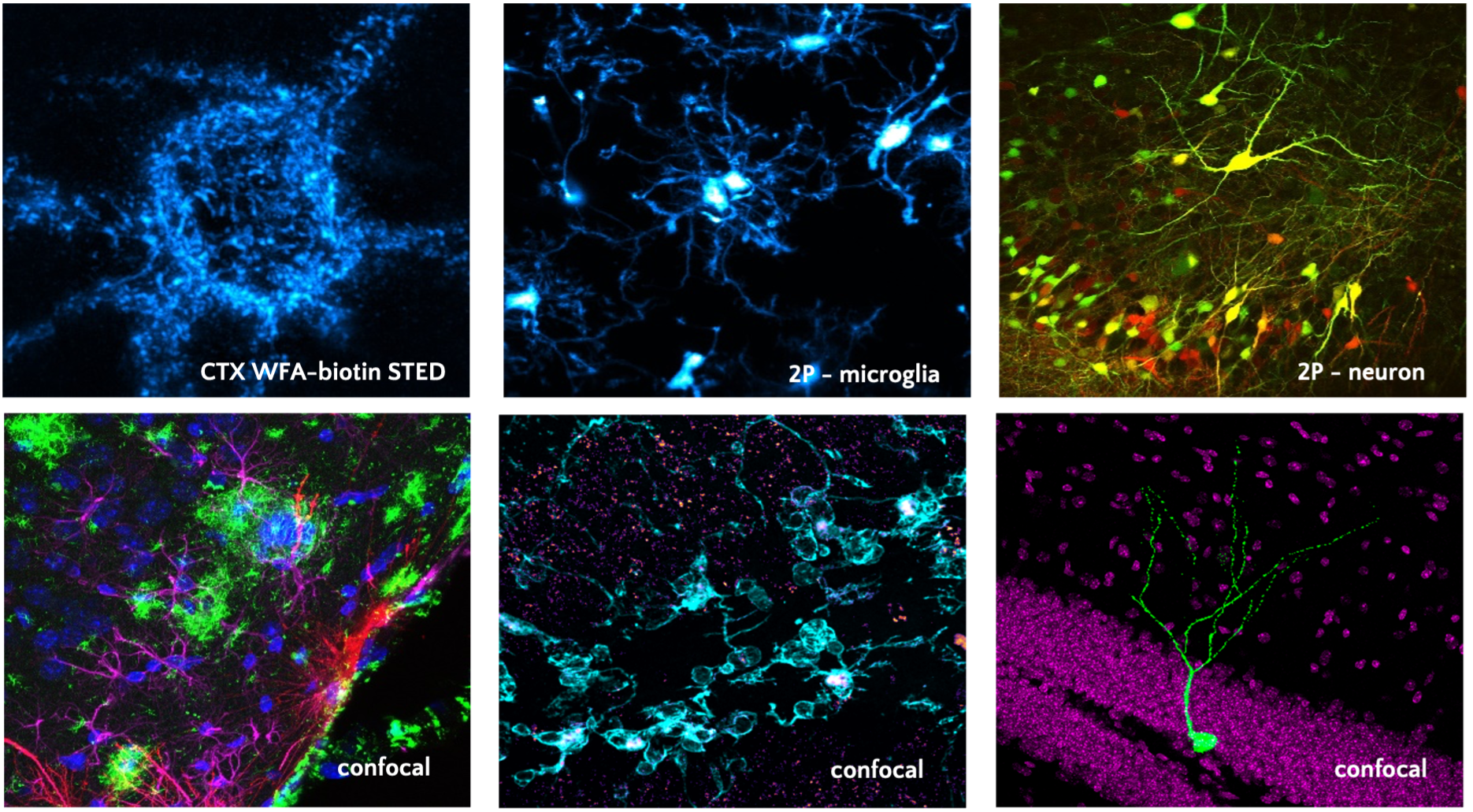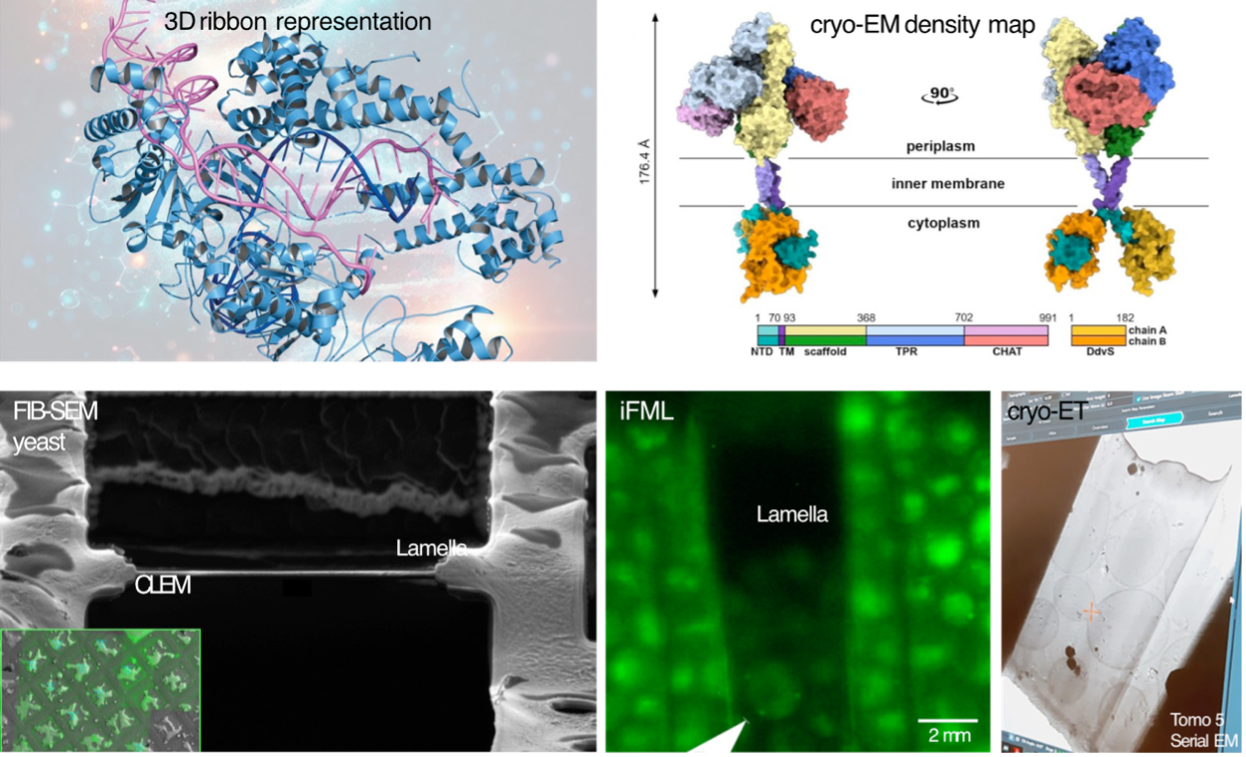SPAIN
Bilbao Node
Located within the Science Park of the University of the Basque Country (UPV/EHU) in the Bilbao metropolitan area, the Bilbao node conducts quantitative research on cellular processes, focusing on molecular interactions and biophysical phenomena such as lipid-mediated protein interactions. The node's work includes lipid-order imaging of model membranes and cells, high-resolution structural biology studies of macromolecular assemblies, and studies on the neurobiology of neuron-glial interactions. The Bilbao Node, Spain is a collaborative initiative between the imaging platforms of the Instituto Biofisika (CSIC-UPV/EHU) and the Achucarro Basque Center for Neuroscience, uniting complementary strengths in advanced light and electron microscopy.
The Bilbao Node serves as a premier resource in the Basque region, providing state-of-the-art microscopy technologies, including super-resolution, confocal, and electron microscopes, as well as live-cell imaging systems that enable high-resolution, three-dimensional, and time-lapse imaging essential for capturing intricate structural details and dynamic processes across biological and material sciences. Alongside this advanced technology, the Node offers expert support and training through workshops, personalized sessions, and assistance with experimental design, data acquisition, and image analysis, empowering researchers to utilize these tools entirely. By fostering an interdisciplinary research environment, the facility brings together scientists from fields such as molecular and structural biology, neuroscience, and materials science, creating a collaborative space where insights from diverse fields converge to advance knowledge through microscopy.
The Node also provides access to sophisticated imaging software and data analysis tools, supporting precise processing and quantification of microscopy data. Open to both academic and industrial researchers, it promotes scientific engagement and innovation, positioning the Basque region as a hub for groundbreaking advances in microscopy and neuroscience on a regional and international level.
Dedicated to understanding the organization and processing of information within neural circuits, the Node focuses on uncovering the genetic and molecular foundations that shape these circuits throughout development and aging. Researchers also investigate the genetic, molecular, and cellular mechanisms that underlie neurodegenerative and autoimmune brain diseases, supporting translational research into novel therapeutic strategies for treating brain disorders. Through its unique combination of advanced imaging technology and expertise—including cryo-electron microscopy (cryo-EM)—the Bilbao Node supports a broad range of scientific studies, with an emphasis on the structural and functional mechanisms that govern biological systems at molecular and cellular levels, particularly within biophysics.
The Bilbao Node integrates three complementary open-access platforms: the Achucarro Imaging Facility, the Basque Resource for Advanced Light Microscopy (BRALM), and the Basque Resource for Electron Microscopy (BREM). Together, they form one of the most advanced cryo-EM infrastructures in southern Europe. Recent developments, such as the installation of a Titan Krios G4 optimized for cryo-electron tomography, an Aquilos2 cryo-FIB-SEM with integrated fluorescence microscopy (iFLM), and the Talos F200i, have significantly enhanced regional capabilities. These systems enable high-resolution structural and functional studies of biological specimens including cryo-CLEM workflows, and address key technological and geographic gaps in European microscopy infrastructure. This comprehensive platform supports cutting-edge research and facilitates collaboration across academia and industry.


Offered Technologies
Deconvolution widefield microscopy (DWM)
Laser scanning confocal microscopy (LSCM/CLSM)
Spinning disk confocal microscopy (SDCM)
Total internal reflection fluorescence microscopy (TIRF)
Two-photon microscopy (2P)
Single Molecule localisation microscopy (SMLM)
Stimulated emission depletion microscopy (STED)
Single Particle Tracking (SPT)*
Lightsheet Mesoscopic Imaging (SPIM /sDSLM)
Fluorescence Recovery after Photobleaching (FRAP)
Microdissection *
Fluorescence Lifetime Imaging (FLIM)
High Throughput Microscopy / High-Content Screening (HTM/HCS)
Fluorescence Resonance Energy Transfer (FRET)
Fluorescence (cross)-correlation spectroscopy (FCS/FCCS)
Voltage/pH/Ion Imaging *
Photomanipulation
Expansion Microscopy *
Tissue Clearing*
Single Molecule FRET*
Atomic Force Microscopy* (AFM)
Cryo-EM
Cryo Electron Tomography (Cryo-ET)
Cryo Transmission Electron Microscopy (Cryo-TEM)
Cryo Focussed Ion Beam (Cryo-FIB)
Cryo Scanning Electron Microscopy (Cryo-SEM)
Cryo-CLEM
Image analysis -bio (IA-bio)*
Additional services offered by the Node
Fluorescent Activated Cell Sorter (FACS)
Fluorescence and brightfield Automatic Digital Slide Scanner
Biomodel Platform for Human Research
Plunge Freezers (Vitrobot Mark IV and Leica EM GP2)
High-Pressure Freezer (Leica EM ICE)
Glow discharge system (Corduan Technologies)
Sputter coater/evaporator system (Quorum Q150V ES Plus)
Plasma Cleaner (Gatan Solarus II System)
Micropatterning system (PRIMO, Alvéole)
Contact details
Dra. Laura Escobar
Achucarro Imaging Facility
Achucarro Basque Center for Neuroscience
Science Park of the UPV/EHU
Sede Building, 3rd floor
Barrio Sarriena s/n
48940 Leioa, Bizkaia (Spain)
https://www.achucarro.org/facilities/imaging/
Dr. Artur Escalada
Basque Resource for Advanced Light Microscopy (BRALM)
Instituto Biofisika (CSIC-UPV/EHU)
Science Park of the UPV/EHU
Barrio Sarriena s/n
48940 Leioa, Bizkaia (Spain)
Dr. David Gil-Carton
Basque Resource for Electron Microscopy (BREM)
Instituto Biofisika (CSIC-UPV/EHU)
Science Park of the UPV/EHU
Barrio Sarriena s/n
48940 Leioa, Bizkaia (Spain)